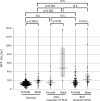Surgical Methods and Experiences of Surgeons did not Significantly Affect the Recovery in Phonation Following Reconstruction of the Recurrent Laryngeal Nerve
- PMID: 27431320
- PMCID: PMC5104804
- DOI: 10.1007/s00268-016-3634-7
Surgical Methods and Experiences of Surgeons did not Significantly Affect the Recovery in Phonation Following Reconstruction of the Recurrent Laryngeal Nerve
Abstract
Background: We reported phonatory recovery in the majority of 88 patients after recurrent laryngeal nerve (RLN) reconstruction. Here we analyzed factors that might influence the recovery, in a larger patient series.
Methods: At Kuma Hospital, 449 patients (354 females and 95 males) underwent RLN reconstruction with direct anastomosis, ansa cervicalis-to-RLN anastomosis, free nerve grafting, or vagus-to-RLN anastomosis; 47.4 % had vocal cord paralysis (VCP) preoperatively. Maximum phonation time (MPT) and mean airflow rate during phonation (MFR) were measured 1 year post surgery. Forty patients whose unilateral RLNs were resected and not reconstructed and 1257 normal subjects served as controls.
Results: Compared to the VCP patients, the RLN reconstruction patients had significantly longer MPTs 1 year after surgery, nearing the normal values. The MFR results were similar but less clear. Detailed analyses of 228 female patients with reconstruction for whom data were available revealed that none of the following factors significantly affected phonatory recovery: age, preoperative VCP, method of reconstruction, site of distal anastomosis, use of magnifier, thickness of suture thread, and experience of surgeon. Of these 228 patients, 24 (10.5 %) had MPTs <9 s 1 year after surgery, indicating insufficient recovery in phonation. This insufficiency was also not associated with the factors mentioned above.
Conclusions: Approximately 90 % of patients who needed resection of the RLN achieved phonatory recovery following RLN reconstruction. The recovery was not associated with gender, age, preoperative VCP, surgical method of reconstruction, or experience of the surgeon. Performing reconstruction during thyroid surgery is essential whenever the RLN is resected.
Conflict of interest statement
Compliance with ethical standards Conflicts of interest The authors state that there are no conflicts of interest related to this study.
Figures









Comment in
-
Letter to Editor in Response to the Article Entitled "Surgical Methods and Experiences of Surgeons Did Not Significantly Affect the Recovery in Phonation Following Reconstruction of the Recurrent Laryngeal Nerve".World J Surg. 2017 Jan;41(1):330. doi: 10.1007/s00268-016-3721-9. World J Surg. 2017. PMID: 27646282 No abstract available.
-
Surgical Methods and Experiences of Surgeons did not Significantly Affect the Recovery in Phonation Following Reconstruction of the Recurrent Laryngeal Nerve: Reply.World J Surg. 2017 Jan;41(1):331-332. doi: 10.1007/s00268-016-3806-5. World J Surg. 2017. PMID: 27834013 No abstract available.
Similar articles
-
Selective vagus-recurrent laryngeal nerve anastomosis in thyroidectomy with cancer invasion or iatrogenic transection.Langenbecks Arch Surg. 2020 Jun;405(4):461-468. doi: 10.1007/s00423-020-01906-y. Epub 2020 Jun 6. Langenbecks Arch Surg. 2020. PMID: 32504208
-
Improvement in phonation after reconstruction of the recurrent laryngeal nerve in patients with thyroid cancer invading the nerve.Surgery. 2009 Dec;146(6):1056-62. doi: 10.1016/j.surg.2009.09.018. Surgery. 2009. PMID: 19958932
-
Bridging gaps between the recurrent laryngeal nerve and ansa cervicalis using autologous nerve grafts.J Voice. 2013 May;27(3):381-7. doi: 10.1016/j.jvoice.2013.01.009. Epub 2013 Mar 13. J Voice. 2013. PMID: 23490127
-
Immediate Intraoperative Repair of the Recurrent Laryngeal Nerve in Thyroid Surgery.Laryngoscope. 2021 Jun;131(6):1429-1435. doi: 10.1002/lary.29204. Epub 2020 Oct 29. Laryngoscope. 2021. PMID: 33118630 Review.
-
Laryngeal Reinnervation: The History and Where We Stand Now.Adv Otorhinolaryngol. 2020;85:98-111. doi: 10.1159/000456688. Epub 2020 Nov 9. Adv Otorhinolaryngol. 2020. PMID: 33166981 Review.
Cited by
-
Selective vagus-recurrent laryngeal nerve anastomosis in thyroidectomy with cancer invasion or iatrogenic transection.Langenbecks Arch Surg. 2020 Jun;405(4):461-468. doi: 10.1007/s00423-020-01906-y. Epub 2020 Jun 6. Langenbecks Arch Surg. 2020. PMID: 32504208
-
Letter to Editor in Response to the Article Entitled "Surgical Methods and Experiences of Surgeons Did Not Significantly Affect the Recovery in Phonation Following Reconstruction of the Recurrent Laryngeal Nerve".World J Surg. 2017 Jan;41(1):330. doi: 10.1007/s00268-016-3721-9. World J Surg. 2017. PMID: 27646282 No abstract available.
-
Long-term quality of voice is usually acceptable after initial hoarseness caused by a thyroidectomy or a parathyroidectomy.Gland Surg. 2019 Jun;8(3):226-236. doi: 10.21037/gs.2018.09.02. Gland Surg. 2019. PMID: 31328101 Free PMC article.
-
Optimal Management of the Unilateral Recurrent Laryngeal Nerve Involvement in Patients with Thyroid Cancer.Cancers (Basel). 2021 Apr 28;13(9):2129. doi: 10.3390/cancers13092129. Cancers (Basel). 2021. PMID: 33925053 Free PMC article.
-
The Role of Primary Repair of the Recurrent Laryngeal Nerve during Thyroid/Parathyroid Surgery in Vocal Outcomes-A Systematic Review.J Clin Med. 2023 Feb 3;12(3):1212. doi: 10.3390/jcm12031212. J Clin Med. 2023. PMID: 36769864 Free PMC article. Review.
References
-
- Randolph GW. Surgical anatomy and monitoring of the recurrent laryngeal nerve. In: Randolph GW, editor. Surgery of the thyroid and parathyroid glands. 2. Philadelphia: Elsevier; 2013. pp. 311–318.
MeSH terms
LinkOut - more resources
Full Text Sources
Other Literature Sources
Miscellaneous

